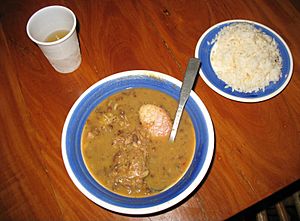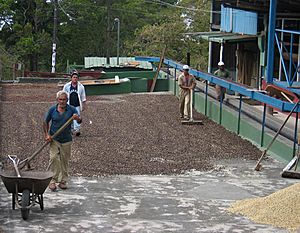Panamanian cuisine facts for kids
Panamanian cuisine is a delicious mix of flavors from Africa, Spain, and Native American traditions. This shows how diverse the people of Panama are! Since Panama is a land bridge connecting two continents, it has many different tropical fruits, vegetables, and herbs that are used in cooking.
Common ingredients you'll find in Panamanian food include corn, rice, wheat flour, plantains, yuca (cassava), beef, chicken, pork, and fresh seafood.
Contents
Tasty Dishes

Many Panamanian dishes use corn. The corn kernels are cooked, then ground to make a dough. Fresh corn is also used in some meals. Because Panama has so many different cultures, its dishes are influenced by other Latin American and Caribbean countries, as well as Europe. Here are some popular meals and specialties:
- Almojábanos – These are "S" shaped fritters made from corn.
- Arroz con camarones y coco – Rice cooked with shrimp and creamy coconut milk.
- Arroz con pollo – A classic dish of rice mixed with chicken.
- Bollos – Corn dough wrapped in leaves and boiled. They can be made from fresh or dry corn. Sometimes they are stuffed with beef, called "bollo preñado."
- Carimañola – Similar to an empanada, but made from yuca dough and filled with beef.
- Ceviche – A refreshing dish usually made with corvina or tilapia fish, marinated in citrus juices.
- Empanadas – These can be made with flour or corn dough. They are filled with meats, vegetables, cheese, or even sweet fillings like fruit jam.
- Hojaldres/Hojaldras – A type of fried bread, often eaten for breakfast.
- Lengua guisada – Beef tongue cooked in a stew.
- Plátano en tentacion – Ripe plantains cooked in a sweet syrup, making them soft and delicious.

- Sancocho – A very popular and hearty soup, often made with chicken, yuca, and other vegetables.
- Tamales – Corn dough filled with meat and other ingredients, then wrapped in leaves and steamed.
- Tortillas – These can be large and cooked on a griddle, or smaller and fried.
- Torrejitas de maíz – A type of fresh corn fritter.
Sweet Desserts
Panama has many sweet treats to enjoy after a meal:
- Bocadillo – Hard, square candies made from milk.
- Bolitas de tamarindo – Sweet and sour balls made with tamarind fruit and sugar.
- Cocadas – Delicious coconut candies, sometimes made with condensed milk.
- Flan – A creamy, sweet custard dessert with a caramel topping.
- Huevitos de leche – Small, round milk candies.
- Manjar or manjar blanco – A sweet, thick spread similar to dulce de leche.
- Mazamorra or pesada de nance – A thick, sweet porridge made from the nance fruit.
- Suspiros – Light, airy wafers made from flour.
- Tres leches – A very moist cake soaked in three kinds of milk.
Refreshing Drinks
Panama offers many refreshing drinks, perfect for its tropical climate:
- Beer – A common alcoholic beverage for adults.
- Chicha – A traditional drink often made from fermented corn or fruits.
- Chicheme – A creamy, sweet drink made from corn and milk.
- Coffee – Panama is known for its high-quality coffee, especially from regions like Boquete.
- Fresh fruit juices (licuados or jugos naturales) – Made by blending fresh tropical fruits like pineapple, passionfruit, papaya, and orange. They are usually sweetened and sometimes have condensed milk added.
- Ron ponche – A traditional creamy drink, similar to eggnog, often enjoyed during special occasions.
Spices and Flavors
Panamanian cooking uses special spices to give its dishes unique flavors:
- Achiote – A common spice that gives food a beautiful orange-red color and a mild, earthy flavor.
- Aji chombo – A very hot pepper grown in local regions, used to add a spicy kick to dishes.
Special Occasions
Christmas Feast
Christmas in Panama is a time for delicious traditional foods. The meal often includes chicken tamales, arroz con pollo (rice with chicken), roasted pork (puerco asado or pernil), pavo (turkey), and relleno (stuffing). Tables are also filled with bowls of fresh fruits and fruitcake. A special drink called Ron Ponche (similar to eggnog) is also served, often made with condensed milk, evaporated milk, eggs, rum, and nutmeg.
See also
 In Spanish: Gastronomía de Panamá para niños
In Spanish: Gastronomía de Panamá para niños




